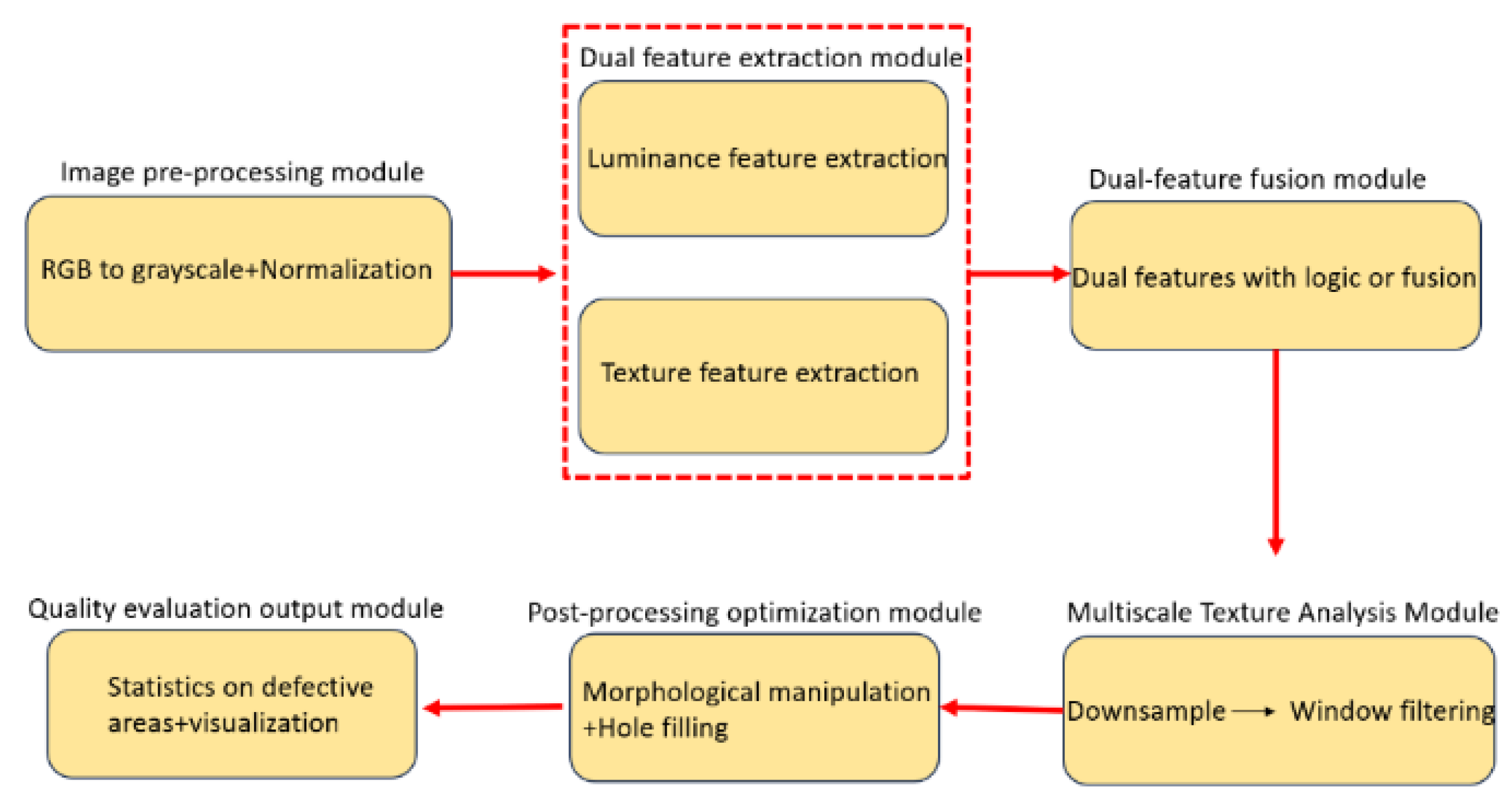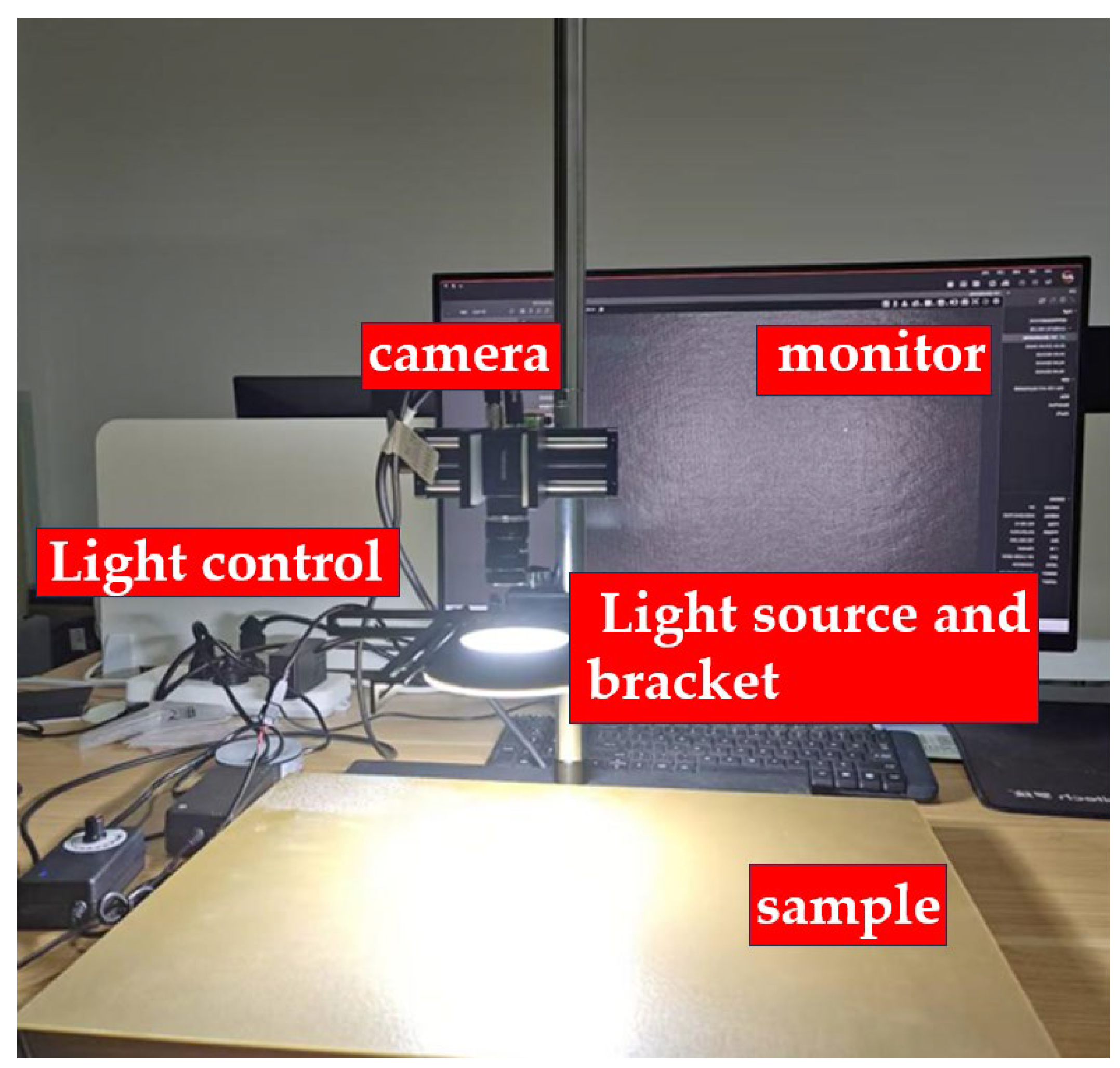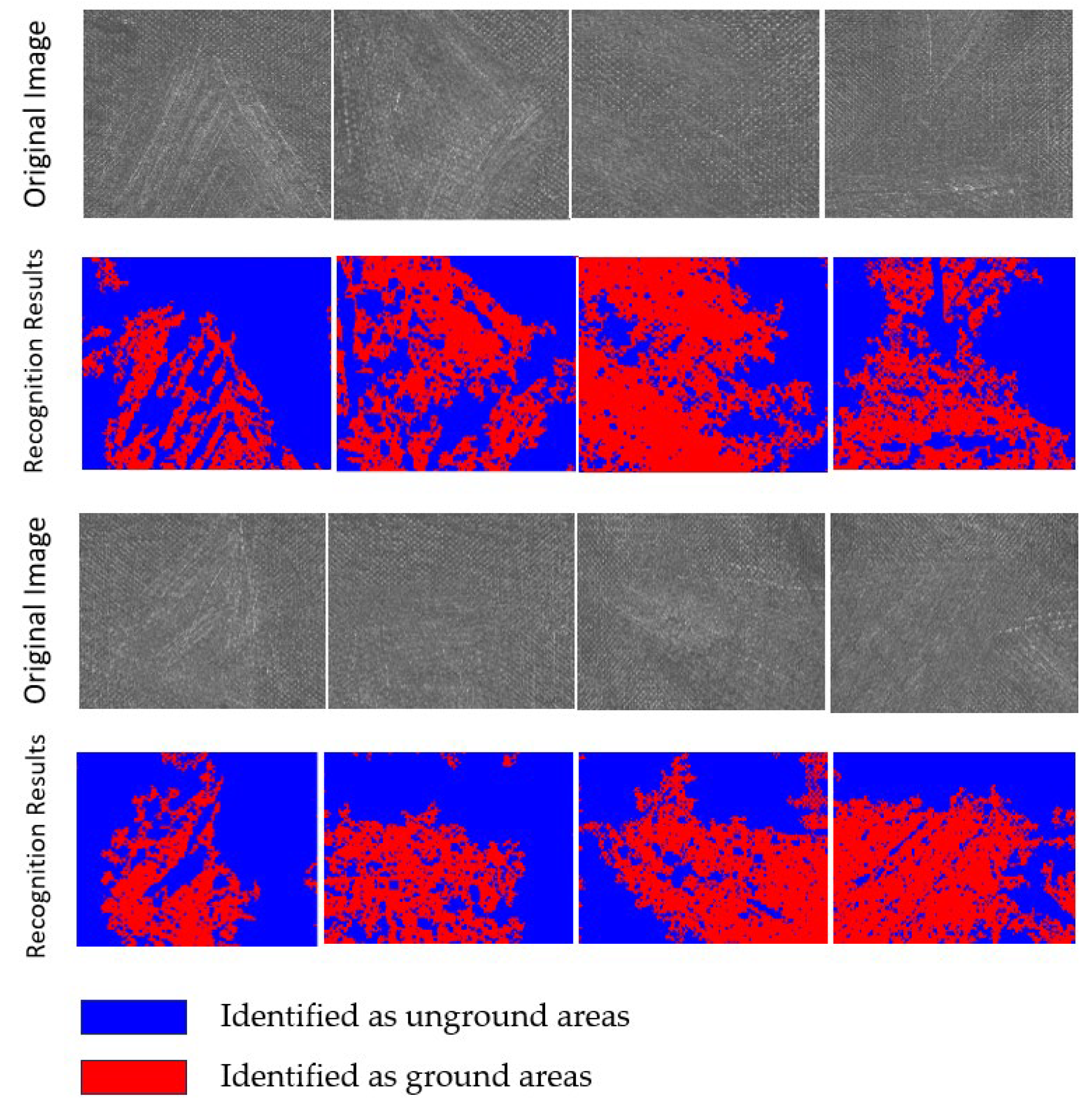Research on the Grinding Quality Evaluation of Composite Materials Based on Multi-Scale Texture Fusion Analysis
Abstract
1. Introduction
2. Algorithm Core Framework
2.1. Texture Feature Analysis
2.2. Luminance Feature Characterization
2.3. Enhanced Dual-Threshold Otsu Algorithm
2.4. Multi-Scale Texture Characterization
3. Experiments
3.1. Experimental Image Acquisition
3.2. Experimental Environment and Evaluation Metrics
3.3. Experimental Reliability Analysis
3.3.1. Analysis of RMSE-Based Results
3.3.2. Reliability Analysis Based on Dual Feature Fusion
4. Conclusions
- 1.
- Leveraging the optical characteristics of the material surface, the algorithm incorporates brightness analysis combined with a modified Rayleigh distribution to perform preliminary segmentation of unpolished high-brightness regions, thereby improving recognition efficiency.
- 2.
- An optimized Otsu algorithm is introduced, incorporating global gray value and standard deviation . This modification overcomes the traditional Otsu algorithm’s limitations—its reliance on single gray histograms and its ineffectiveness at integrating multimodal features such as texture and gradient—enabling the simultaneous detection of both specular reflection defects and texture uniformity variations.
- 3.
- A maximum value fusion strategy integrates features extracted across different scales. This approach effectively preserves significant features at window sizes of 15, 30, and 60, improving the detection rate of minor pits.
- 4.
- By optimizing algorithm parameters based on environmental conditions, the experimental accuracy was increased to 96%, while algorithm reliability reached over 95%.
Author Contributions
Funding
Institutional Review Board Statement
Informed Consent Statement
Data Availability Statement
Conflicts of Interest
References
- Singh, J.; Srivastawa, K.; Jana, S.; Dixit, C. Advancements in lightweight materials for aerospace structures: A comprehensive review. Acceleron Aerosp. J. 2024, 2, 173–183. [Google Scholar] [CrossRef]
- Hamzat, A.K.; Murad, S.; Adediran, I.A.; Asmatulu, E.; Asmatulu, R. Fiber-reinforced composites for aerospace, energy, and marine applications: An insight into failure mechanisms under chemical, thermal, oxidative, and mechanical load conditions. Adv. Compos. Hybrid Mater. 2025, 8, 152. [Google Scholar] [CrossRef]
- Montgomery-Liljeroth, E.; Schievano, S.; Burriesci, G. Elastic properties of 2D auxetic honeycomb structures-a review. Appl. Mater. Today 2023, 30, 101722. [Google Scholar] [CrossRef]
- Liu, Y.; Zhang, C.; Dong, X. A survey of real-time surface defect inspection methods based on deep learning. Artif. Intell. Rev. 2023, 56, 12131–12170. [Google Scholar] [CrossRef]
- Naat, N.; Boutar, Y.; Naïmi, S.; Mezlini, S.; Da Silva, L.F.M. Effect of surface texture on the mechanical performance of bonded joints: A review. J. Adhes. 2023, 99, 166–258. [Google Scholar] [CrossRef]
- Jha, S.B.; Babiceanu, R.F. Deep CNN-based visual defect detection: Survey of current literature. Comput. Ind. 2023, 148, 103911. [Google Scholar] [CrossRef]
- Le, H.F.; Zhang, L.J.; Liu, Y.X. Surface Defect Detection of Industrial Parts Based on YOLOv5. IEEE Access 2022, 10, 130784–130794. [Google Scholar] [CrossRef]
- Singh, S.A.; Desai, K.A. Automated surface defect detection framework using machine vision and convolutional neural networks. J. Intell. Manuf. 2023, 34, 1995–2011. [Google Scholar] [CrossRef]
- Bayraktar, E. Efficient and Reliable Surface Defect Detection in Industrial Products Using Morphology-Based Techniques. In International Symposium on Intelligent Manufacturing and Service Systems; Springer Nature: Singapore, 2023. [Google Scholar] [CrossRef]
- Üzen, H.; Türkoğlu, M.; Yanikoglu, B.; Hanbay, D. Swin-MFINet: Swin transformer based multi-feature integration network for detection of pixel-level surface defects. Expert Syst. Appl. 2022, 209, 118269. [Google Scholar] [CrossRef]
- Slavov, D.V.; Hristov, V.D. 3D machine vision system for defect inspection and robot guidance. In Proceedings of the 2022 57th International Scientific Conference on Information, Communication and Energy Systems and Technologies (ICEST), Ohrid, North Macedonia, 16–18 June 2022. [Google Scholar] [CrossRef]
- Xia, B.; Luo, H.; Shi, S. Improved Faster R-CNN Based Surface Defect Detection Algorithm for Plates. Comput. Intell. Neurosci. 2022, 2022, 3248722. [Google Scholar] [CrossRef] [PubMed]
- Huang, T.; Zhao, L.; Zhang, Y.; Tian, J.; Zhou, W. A Lightweight Fine-Grained Perception Defect Inspection Network Under Multitask Learning on Highly Reflective Surface. IEEE Trans. Instrum. Meas. 2024, 73, 5008310. [Google Scholar] [CrossRef]
- Muravyov, S.V.; Nguyen, D.C. Method of interval fusion with preference aggregation in brightness thresholds selection for automatic weld surface defects recognition. Measurement 2024, 236, 114969. [Google Scholar] [CrossRef]
- Wang, Y.; Wang, X.; Hao, R.; Lu, B.; Huang, B. Metal Surface Defect Detection Method Based on Improved Cascade R-CNN. ASME J. Comput. Inf. Sci. Eng. 2024, 24, 041002. [Google Scholar] [CrossRef]






| Limitation Category | Traditional Otsu | Enhanced Otsu Solution |
|---|---|---|
| Noise Sensitivity | High noise sensitivity | morphological preprocessing |
| Uneven Illumination | Single global threshold | Local adaptive thresholding |
| Multi-threshold Limitation | Binary segmentation only | Watershed post-processing |
| Material-Specific Adaptation | Fixed threshold failure | Gray histogram redistribution |
| Property | Value |
|---|---|
| Resolution | 5120 × 3840 |
| Pixel size/μm | 1.4 |
| Working distance/mm | 185 ± 1 |
| Frame rate/(frame·s−1) | 5.9 |
| Field of view/mm2 | 107.5 × 80.2 |
| Unit pixel represents physical distance/μm | 20.8 |
| Property | Value |
|---|---|
| Ply Thickness | 120 ± 5 μm |
| Average Resin Layer Thickness | 15 ± 3 μm |
| Fiber Volume Fraction | 60 ± 2% |
| Algorithm | Accuracy | Reliability | Computational Efficiency |
|---|---|---|---|
| Our Method | 96.0% | >95% | 185 ms/frame |
| Otsu Method | 82.3% | 78% | 92 ms/frame |
| Improved Faster R-CNN | 89.7% | 85% | 320 ms/frame |
| Swin-MFINet | 91.5% | 88% | 410 ms/frame |
Disclaimer/Publisher’s Note: The statements, opinions and data contained in all publications are solely those of the individual author(s) and contributor(s) and not of MDPI and/or the editor(s). MDPI and/or the editor(s) disclaim responsibility for any injury to people or property resulting from any ideas, methods, instructions or products referred to in the content. |
© 2025 by the authors. Licensee MDPI, Basel, Switzerland. This article is an open access article distributed under the terms and conditions of the Creative Commons Attribution (CC BY) license (https://creativecommons.org/licenses/by/4.0/).
Share and Cite
Wang, Y.; Liu, Z.; Ling, L.; Guo, A.; Li, J.; Liu, J.; Wang, C.; Pan, M.; Song, W. Research on the Grinding Quality Evaluation of Composite Materials Based on Multi-Scale Texture Fusion Analysis. Materials 2025, 18, 3540. https://doi.org/10.3390/ma18153540
Wang Y, Liu Z, Ling L, Guo A, Li J, Liu J, Wang C, Pan M, Song W. Research on the Grinding Quality Evaluation of Composite Materials Based on Multi-Scale Texture Fusion Analysis. Materials. 2025; 18(15):3540. https://doi.org/10.3390/ma18153540
Chicago/Turabian StyleWang, Yangjun, Zilu Liu, Li Ling, Anru Guo, Jiacheng Li, Jiachang Liu, Chunju Wang, Mingqiang Pan, and Wei Song. 2025. "Research on the Grinding Quality Evaluation of Composite Materials Based on Multi-Scale Texture Fusion Analysis" Materials 18, no. 15: 3540. https://doi.org/10.3390/ma18153540
APA StyleWang, Y., Liu, Z., Ling, L., Guo, A., Li, J., Liu, J., Wang, C., Pan, M., & Song, W. (2025). Research on the Grinding Quality Evaluation of Composite Materials Based on Multi-Scale Texture Fusion Analysis. Materials, 18(15), 3540. https://doi.org/10.3390/ma18153540







